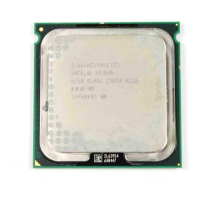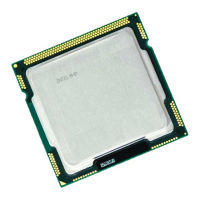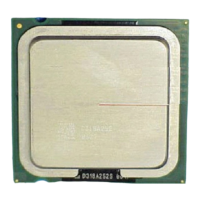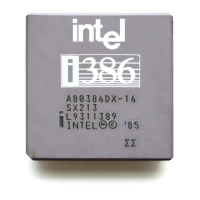Dual-Core Intel® Xeon® Processor 5100 Series Thermal/Mechanical Design Guide 35
Thermal/Mechanical Reference Design
The TIM performance is susceptible to degradation (i.e. grease breakdown) during the
useful life of the processor due to the temperature cycling phenomena. For this reason,
the measured T
CASE
value of a given processor can decrease over time depending on
the type of TIM material.
Refer to Section 2.4.7.2 for information on the TIM used in the Intel reference heatsink
solution.
2.4.3 Summary
In summary, considerations in heatsink design include:
• The local ambient temperature T
LA
at the heatsink, airflow (CFM), the power being
dissipated by the processor, and the corresponding maximum T
CASE
. These
parameters are usually combined in a single lump cooling performance parameter,
Ψ
CA
(case to air thermal characterization parameter). More information on the
definition and the use of Ψ
CA
is given in Section 2.4 and Section 2.3.2.
• Heatsink interface (to IHS) surface characteristics, including flatness and
roughness.
• The performance of the TIM used between the heatsink and the IHS.
• Surface area of the heatsink.
• Heatsink material and technology.
• Development of airflow entering and within the heatsink area.
• Physical volumetric constraints placed by the system.
• Integrated package/socket stackup height information is provided in the LGA771
Socket Mechanical Design Guide.
2.4.4 Assembly Overview of the Intel Reference Thermal
Mechanical Design
The reference design heatsinks that meet the Dual-Core Intel Xeon Processor 5100
Series processors thermal performance targets are called the Common Enabling Kit
(CEK) heatsinks, and are available in 1U, 2U, & 2U+ form factors. Each CEK consists of
the following components:
• Heatsink (with captive standoff and screws)
• Thermal Interface Material (TIM)
•CEK Spring
2.4.4.1 Geometric Envelope
The baseboard keepout zones on the primary and secondary sides and height
restrictions under the enabling component region are shown in detail in Appendix A.
The overall volumetric keep in zone encapsulates the processor, socket, and the entire
thermal/mechanical enabling solution.

